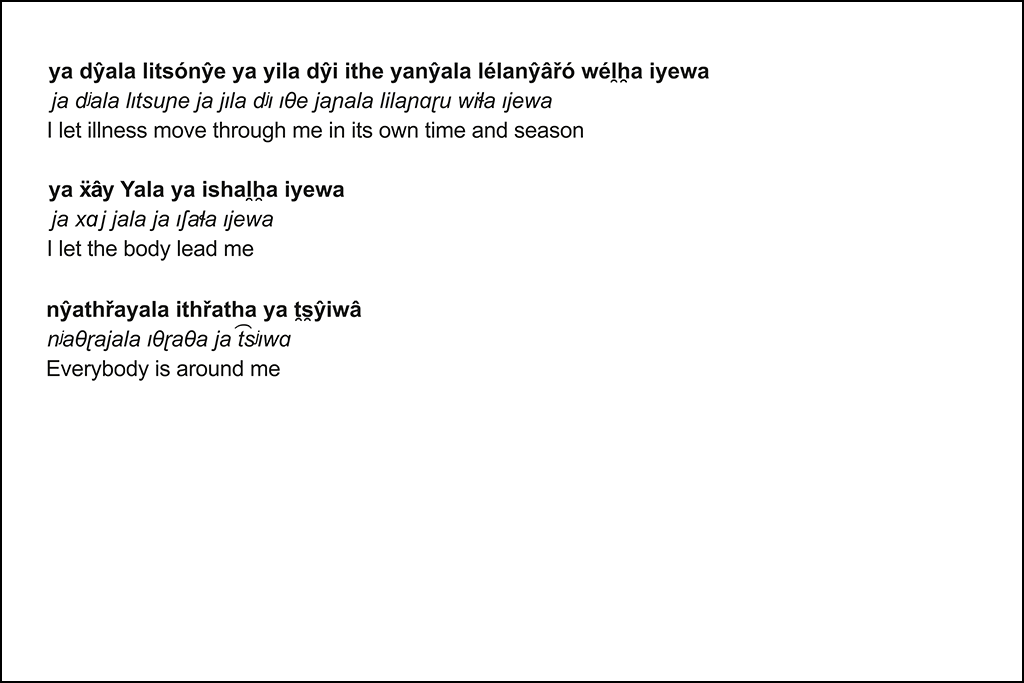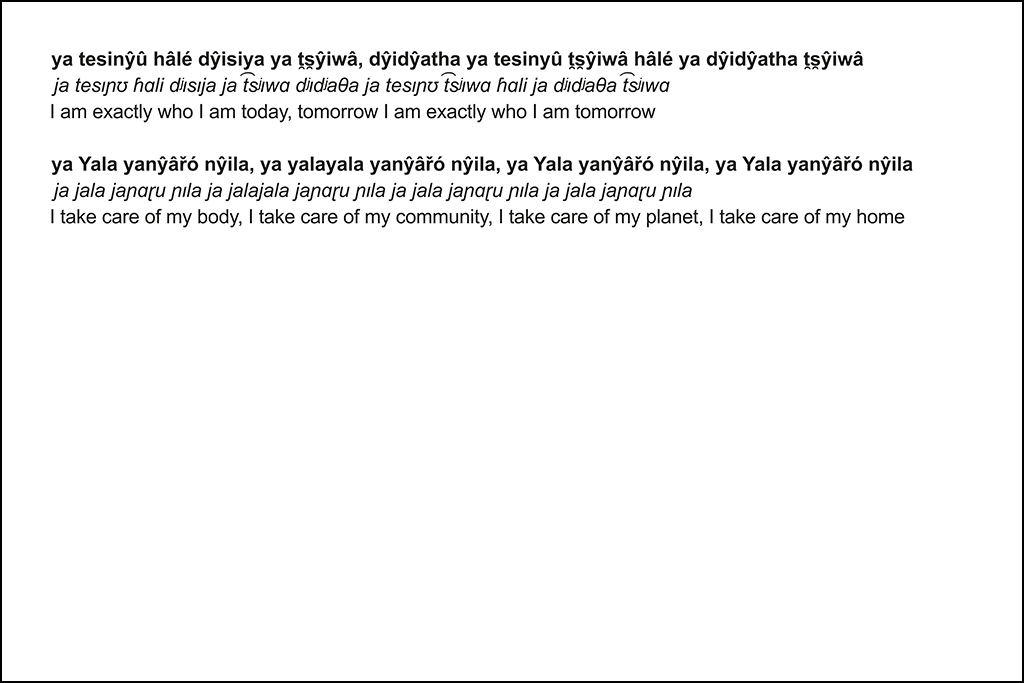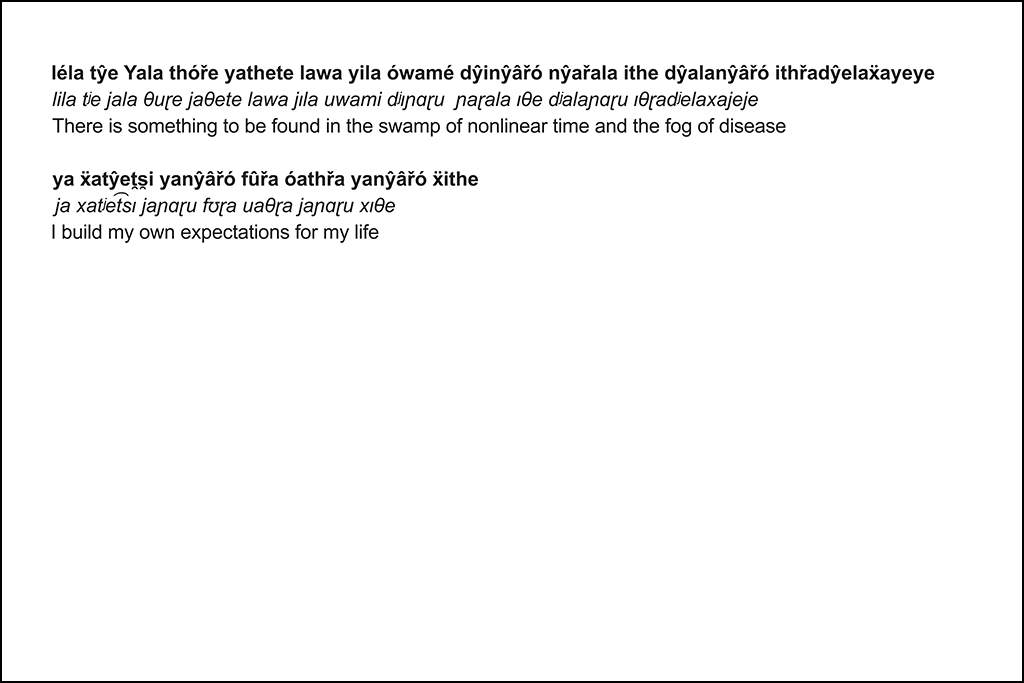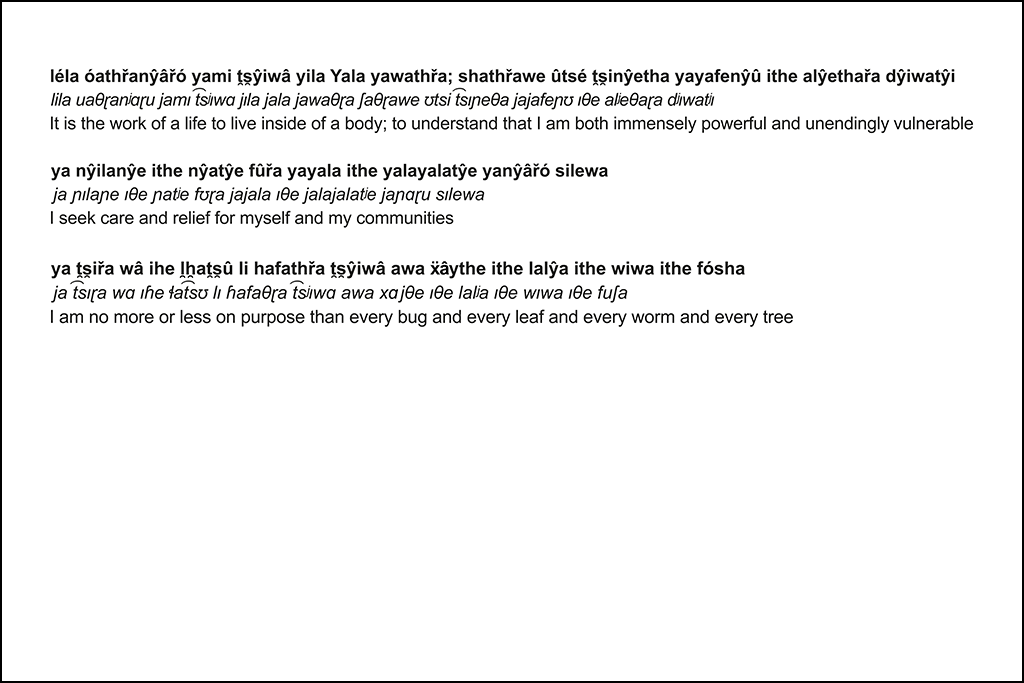Audio Description
RA Walden, ẍây ithřa: a pledge, audio description, 05:33. Courtesy of Rebecca Singh.




RA Walden, ẍây ithřa: a pledge, 2021. Images courtesy the artist.
Audio Description – Transcript
This work is displayed in landscape orientation in a six foot tall by nine foot long lightbox with a black frame. The lower edge of this lightbox’s frame is at doorknob height level.
This image contains three lines of left justified text in ẍây ithřa, a non-English language, each followed by its phonetic transcription and an English translation. The text explores themes of illness, the body, and community. The ẍây ithřa text is bolded for emphasis.
ẍây ithřa: a pledge
Sites Z1-Z4 on the map
Across the four Blackwood lightboxes on UTM campus, ten statements illustrate the foundational concepts of ẍây ithřa (a pledge), a language created by artist RA Walden. Named after the title of this text, ẍây ithřa was developed over several months in close collaboration with linguist Margaret Ransdell Green. It emerged in response to the ableism and limits of the English language, and features a lexicon of over 300 words, with its own morphosyntax, phonology, and an expanding set of idioms. Drawing from histories of queering language–from argots and cants to anti-languages and constructed languages in science fiction–Walden brings fluidity, ease, and “access intimacy” to those in sick, disabled, and trans bodies. Here, world-building is not a tool for an imagined future, but an embodied methodology for the present.
In ẍây ithřa, the word Yala means body, home, and planet earth. It has been translated as body for ease of reading, but the meaning of each statement that contains the word Yala cannot be understood without grasping the way that the body is conceptualised within ẍây ithřa as being both a physical body, the home of a being or community, and the celestial body of planet earth.
Yala is the only word that is capitalised within ẍây ithřa; punctuation is used as expected but a capital letter is not required following a full stop. Capitalisation can be used as an emphasis tool at the pleasure of the writer.
ẍây ithřa uses words that describe the elements/conditions of the earth to describe experiences of the body. For example, a sharp pain may be described as ẍâwehethřathařa: a rock tumbling down a mountain or aẍřaithřahethřa: lightning striking. An experience of fatigue could be described as felathařaẍat̯s̯ŷi: sinking into mud or dŷelathařaxat̯s̯ŷi: pulled under water. The easing of pain might be expressed as wél̯h̯athřafóshâtŷama: wind caressing trees or dŷathathelalayala: sun breaking through clouds.
These are compound words, created in that way to show respect for the elements that form them. For example, ẍâwehethřathařa: a rock tumbling down a mountain is made up of the words rock + above + below. dŷelathařaxat̯s̯ŷi: pulled under water is made up of the words water + below + without consent. dŷathathelalayala: sun breaking through clouds is made up of the words sun + cloud + hello (which is, in turn, a compound word made up of the words body + to be here).
Time is understood within ẍây ithřa to be nonlinear/circular/simultaneous, or in a disability-centered sense, crip time (1). This means that phrases such as today and tomorrow don’t exist within the language, but that notions of time are non-specific (now, soon, later) and inferred by context. This idea centralises those who experience normative time and the culture that grows around that as exclusive, ableist and unmanageable. ẍây ithřan notions of time prioritise slowness, intuitive/body-centered decision-making, and an understanding that the body and its needs must come before requirements of productivity or man-made (read profit-led) deadlines.
(1) See ‘Notes for “Sick Time, Sleepy Time, Crip Time: Against Capitalism’s Temporal Bullying” in conversation with the Canaries’: Taraneh Fazeli, ‘Six Ways of Looking at Crip Time’: Ellen Samuels, ‘Feminist, Queer, Crip’: Alison Kafer.

The Blackwood
University of Toronto Mississauga
3359 Mississauga Road
Mississauga, ON L5L 1C6
[email protected]
(905) 828-3789
The galleries are currently open. Hours of operation: Monday–Saturday, 12–5pm.
Facebook | Twitter | Instagram
Sign up to receive our newsletter.
The Blackwood is situated on the Territory of the Mississaugas of the Credit, Seneca, and Huron-Wendat.